|
|
|

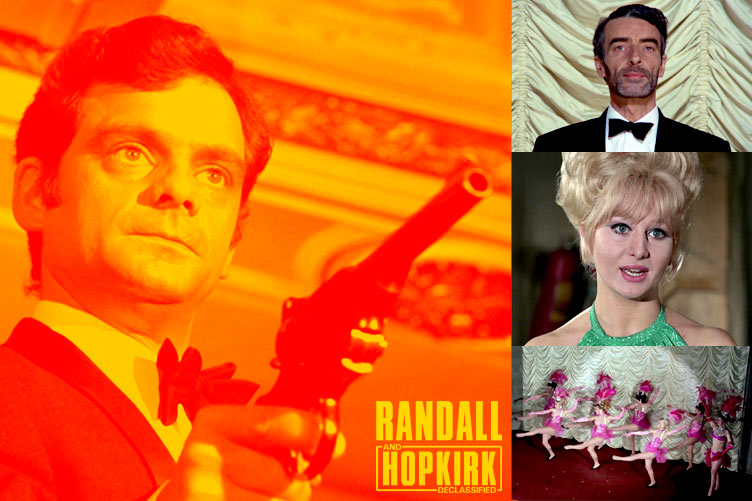
|
Images © ITV Studios, 1968 /
Composition @ Alan Hayes © 2024 |
|
Writer: Ray Austin
Director: Paul Dickson |
|
ORIGINAL ITC SYNOPSIS |
|
Music-hall, mind-reading and murder are the
ingredients for a mystery to be solved by
Randall and Hopkirk when an entertainer is shot
dead in full view of the audience.

Death comes
to one member of a mind-reading act when
reaching the "Russian Roulette" part of the turn
when his partner asks a member of the audience
to load the gun. One cartridge is live; the
others blank. The routine has been performed
time and time again, but this time the live
cartridge is in the wrong chamber.
The victim is
Fernandez. And his partner Abel is accused of
the murder.
But Jeff
Randall, who is in the audience with Jean
Hopkirk, is convinced that Abel is innocent. He
has heard the dead man's last whispered words,
"He said he would kill me..."
Who is "he"?
And who could have switched the bullets? The
member of the audience who put the cartridges
into the gun was a woman, and she has
disappeared.
The ghostly
Marty Hopkirk comes forward with the plan to
enable Jeff to carry out his investigations at
close quarters. Jeff poses as a one-man
mind-reading act and is accepted as a
replacement on the variety bill - giving a
successful performance, thanks to Marty's
invisible help. And, behind the scenes, he meets
the other members of the company, including the
star of the programme, singer Gloria Marsh and
the choreographer, Kim.
In searching
the dead man's belongings in the theatre
storeroom, Jeff is attacked and the only clue to
the assailant is a brief glimpse of a pair of
feminine legs. But his foray has one useful
outcome. He has found old newspaper cuttings
which reveal that Gloria and Fernandez were
married. Another clipping reports an accident in
which Fernandez was exonerated of blame after
the death of a man run down by his car.
From these
two clues, Jeff is able to piece together the
drama and tragedy of blackmail and an impossible
love, but not before another murder and a
further attempted murder and another attack on
himself when he encounters the mystery woman. |
|
|
PRODUCTION & ARCHIVE |
Production
Code:
RH/DCW/4011
Filming Dates: Oct-Nov 1968
Production Completed: Mid-Apr 1969
Recording Format: 35mm Colour Film
Archive Holding: 35mm Colour Film |
|
UK REGIONAL PREMIERES |
Anglia: Sun 27 Sep 1970, 3.00pm (M)
ATV: Fri 10 Oct 1969, 7.30pm (M)
Border: Fri 30 Jan 1970, 7.30pm (M)
Channel: Fri 10 Oct 1969, 7.30pm (M)
Grampian: Thur 12 Mar 1970,
7.00pm (M)
Granada: Fri 10 Oct 1969, 7.30pm (M)
Harlech: Fri 10 Oct 1969, 7.30pm (M)
LWT: Sun 19 Oct 1969,
7.25pm (M)
Scottish: Sat 11 Mar 1972,
8.05pm
Southern: Sun 26 Oct 1969,
7.25pm (M)
Tyne Tees: Sun 2 Aug 1970,
9.05pm
Ulster: Fri 10 Oct 1969,
7.30pm (M)
Westward: Fri 10 Oct 1969, 7.30pm (M)
Yorkshire: Fri 10 Oct 1969,
7.30pm (M) |
(M) =
Transmitted in Monochrome/Black and White
(M*) = Transmitted in B/W due to ITV Colour
Strike |
|
CHARACTERS & CAST |
Jeff
Randall
Marty Hopkirk
Jean Hopkirk
Gloria Marsh
Snowy
Barry Jones
Tony Lang
Kay
Inspector Nelson
Mark
Fernandez
Abel
Old Lady
Kim
The Doctor
The Ventriloquist
Man with Cards |
Mike Pratt
Kenneth Cope
Annette Andrι
Grazina Frame
Arthur Brough
Patrick Holt
Harold Berens
Valerie Leon
Michael Griffiths
James Belchamber
Tony Thawnton
David Jason
Marie Makino
Stuart Hoyle
John Cazabon
John Styles
Simon Barnes |
|
UNCREDITED |
Call Boy (Jimmy)
Dancer
Chorus Girl
Audience Member
Audience Member
Audience Member
Audience Member
Commissionaire
Policeman with Kay |
Robin Askwith
Luan Peters
Pauline Chamberlain
Lewis Alexander
Douglas Cooper
Victor Harrington
Aileen Lewis
Mike Stevens
Walter Henry |
|
STAND-INS |
Jeff Randall
Marty Hopkirk
Jean Hopkirk |
Harry Fielder
Dougie Lockyer
Tina Simmons |
|
STUNT DOUBLES |
|
Jeff Randall |
Rocky Taylor |
|
BLU-RAY
RESTORATION |
|
35mm Negative /
Optical soundtrack
(magnetic soundtrack does not
exist) |
|
EPISODE SPECIAL FEATURES |
|
Commentary by writer Ray Austin and Brian Clemens
(2007), Photo Gallery |
|
ORIGINAL SOUNDTRACK |
|
Music for this
episode was recycled from stock and therefore no
release of a soundtrack of That's How Murder
Snowballs has been issued |
|
|
PRODUCTION CREDITS |
|
An ITC Production
Writer Ray Austin
Series Theme / Musical Director Edwin Astley
Series Creator / Executive Story Consultant Dennis
Spooner
Creative Consultant - Cyril Frankel
Producer Monty Berman
Director Paul Dickson |
|
Production
Supervisor Ronald Liles
Director of Photography Gerald Moss
Art Director Charles Bishop
Post Production Philip Aizlewood
Editor Rod Nelson-Keys
Production Manager Jack Morrison
2nd Unit Director Jack Lowin
2nd Unit Cameraman Brian Elvin
Sound Recordists Denis Porter and& Bill Rowe
Sound Editor Guy Ambler
Music Editor Alan Willis
Casting John Owen
Set Dresser Sue Long
Construction Manager Bill Greene
Camera Operator Val Stewart
Assistant Director Michael Meighan
Continuity Sally Ball
Production Buyer Peter Dunlop
Make-Up Supervisor Elizabeth Romanoff
Hairdresser Jeannette Freeman
Wardrobe Supervisor Laura Nightingale
Scenic Artist A. J. Van Montagu
Stunt Co-ordinator Frank Maher
Sound Effects Cinesound
Titles Chambers + Partners
Made on
Location and at Associated British Elstree
Studios, London, England
© Copyright
ITC-INCORPORATED TELEVISION COMPANY LTD MCMLXVIII |
|
|
THAT'S HOW MURDER SNOWBALLS REVIEW |
|
Ray
Austin switched from director to writer for this
episode, and while it is one of the classic entries in
the Randall and Hopkirk (Deceased)
series, it has a touch of Scooby Doo
about it. For starters, after Kim has engineered
Fernandez's death, there appears to be no further
reason for the "mystery woman" to appear,
maybe except to murder Gloria later. Since he took on
the appearance of a woman for both murders, Kim's ability to get away with his crimes
would surely be best served by his not running around
the theatre in drag. Unfortunately, the direction does
not help the mystery, as it's very obvious that the
woman in the audience who swaps the bullets is rather
too masculine to be all that she seems, so the big
revelation at the end of the episode is anything but
that. Otherwise, if
one can overlook these two issues with the episode, it
is a thoroughly enjoyable one. Once again, the script
plays on Marty's ghostliness to make Jeff appear to be
a flawless mind-reader, where in fact Marty is feeding
him all the information, but this allows Jeff to
become a part of the show's company and further his
investigations. The direction, by once-only Randall director Paul Dickson, is competent
and makes excellent use of interiors shot on location,
and these scenes are well-matched with backstage
sequences all of which were filmed at the ABC Elstree
Studios. The episode feels very much like an ensemble
piece, with no one actor or character (outside of the
regulars) given a headlining role, and this definitely
helps the identity of the murderer remain under wraps
(and in fishnet tights) for most of the episode. All
told, That's How Murder Snowballs is a great
episode which, due to its "bottle story" nature,
affords a welcome change of scene and pace for the
series - and which shows off its solitary location to
great advantage. |
|
|
THAT'S HOW MURDER SNOWBALLS DECLASSIFIED |
-
Pre-Titles Teaser...
It is dusk, and the Palace Theatre has attracted a
healthy audience for the evening show. The act
currently on stage is The Fabulous Fernandez and
Abel, who bill themselves as "the greatest mind
reading act in the world". Fernandez is on stage,
wearing a blindfold, while his partner is down among
the audience, strolling up and down the centre
aisle. He holds a stamped envelope in his hand, and
asks Fernandez to tell him the address it carries.
After some deliberation, the mind reader proclaims:
"Mr Bernard Kempson, 23 Tudor Close, Watford". Abel
asks a member of the audience to read the address,
and the audience applauds when it is reveal that
Fernandez was correct. Fernandez removes his
blindfold and Abel then announces the climax of
their act. He holds a six-shot revolver in his hand
and reveals that he has one blank cartridge that he
will ask a member of the audience to place in the
chamber of their choice, then, with the gun aimed at
him, Fernandez will foretell on which chamber the
gun will fire. Abel walks to the seventh row from
the stage and asks a woman to load the gun. The
weapon armed, Abel thanks her and aims the revolver
at Fernandez, alone on the stage. "Are you ready,
Fernandez?" asks Abel of his partner, who confirms
that he is. Abel then asks which chamber the gun
will fire on? Fernandez declares that it will fire
on the third. He is proved right, but the shot
mortally wounds him. The cartridge was live.
Fernandez falls to the floor, and pandemonium reigns
in the Palace Theatre. Jeff Randall and Jeannie
Hopkirk, who had been in the audience watching the
show, dash to the man's aid. Jeff cradles Fernandez
in his arms. The mind reader's last words are "he
said he would kill me," causing Jeff and Jeannie to
look to Abel, who still holds the gun and shakes his
head in denial of the accusation.
-
Production
Brief...
That's How Murder Snowballs was the eleventh episode to
go before the cameras. It was the first television
script that erstwhile director Ray Austin had ever
written, the commission being made possible by
Dennis Spooner, who encouraged the former stuntman
when he expressed a desire to write for Randall and Hopkirk (Deceased). The episode
would be Austin's only script for the series, but he
went on to write for Department S and
Shirley's World for ITC and The
Adventures of Black Beauty for London
Weekend Television, in tandem with a thriving
directorial career, before emigrating to the United
States of America in 1978. In the business there, he
combined writing and directing and was much sought
after for both. In his later years, he turned his
hand to writing novels, his authorial debut being
The Eagle Heist (2002). He was the only person
who both wrote and directed episodes of Randall
and Hopkirk (Deceased).
-
Just
as That's How Murder Snowballs would prove to
be Ray Austin's solitary writing credit for Randall and Hopkirk (Deceased), it also
proved to be a one-off engagement for the episode's
director, Paul Dickson. Born Alan Paul Dickson in
Cardiff on 18th January 1920, he was educated at
Llandaff Cathedral School, and later became a
boarder at Ellesmere College, where he joined the
amateur dramatics group. At the outbreak of war, he
applied to the forces as an ordinary soldier, even
though he would have been officer material, as he
"wanted to experience more". Consequently, he spent
seven years in the Royal Artillery and worked with
the Special Operations Executive in northern Italy
using radar to pinpoint landing operations for
Allied agents. After the war in 1946, he entered the
film industry working as assistant director for Paul
Rotha at Films of Fact, a documentary unit producing
public information films, before moving to World
Wide Pictures. At the turn of the decade, he
collaborated with writer Ted Willis on The
Undefeated (1950), a film Dickson directed
which told the story of how a disabled ex-serviceman
overcame his wartime injuries. The film was
nominated for an Oscar and also won a British Film
Academy Award, judged as Best Documentary. The
next year saw Dickson deliver what many recognise as
his most accomplished work, David
(1951), a drama-documentary focusing on the life of
a school caretaker and poet, David Griffiths. It was
made for the Festival of Britain, commissioned to
represent Wales. Later, in 1960, he directed Stone into Steel, a 35 minute documentary
for the United Steel Companies, which was filmed at
their Scunthorpe Works. This won the Best
Documentary category at the Venice Film Festival and
remains highly acclaimed today. Dickson also showed his flair in
the direction of commercial films, beginning with a
commission for Unilever, and this work ultimately
led to his being invited to ply his trade in the
United States, where he achieved some considerable
success in the field. Returning to Britain in 1966, he quickly picked up where he left off
and made contact with people who he had worked with
at Kenilworth Films and the Danziger Film Studios.
He soon became a favoured director on television
film series such as The Champions and
Department S, and also chalked up
single engagements on The Avengers
and, of course, Randall and Hopkirk (Deceased),
despite having a reputation by then as something of
a hell-raiser. In 1980, Paul was appointed Head of
Direction at the National Film and Television School
in Beaconsfield, where he found great satisfaction
in passing on his knowledge of the industry,
narrative approaches and filming techniques. Paul
Dickson died aged 91 on 6th October 2011.
-
The opening shots
following the title sequence, showing the audience
exiting the auditorium and descending the stairs,
were filmed on a studio mock-up rather than at the
Palace Theatre, Watford. Note the wallpaper that
doesn't quite match that seen through the double
doors from inside the auditorium (the thin dividing
line between the light and dark blue strips is
missing). This choice was no doubt made due to the
difficulties installing cameras and lights in such a
small space in the theatre. Consequently, the extras
seen in the audience had to be available for both
location and studio filming.
-
Exact filming
dates for this episode are unknown, but in his DVD
liner notes, Andrew Pixley stated the filming
was carried out in October and November 1968
and a report in The Stage and Television Today
(28th November 1968) stated that filming had just
been completed on this episode.
-
A fully edited version of this
episode was completed in mid-April 1969.
-
On Location...
Just the one, solitary location beyond the Elstree
Studios backlot was utilised in this episode, but
it was employed for both exterior and interior
filming - the Palace Theatre on Clarendon
Road, Watford. More details in
Locations: That's How Murder Snowballs.
-
Haunting Melodies... Edwin Astley was not asked to compose any
new music cues for That's How Murder Snowballs,
with its score coming entirely from stock. Three pieces
of library music were called up: Opening Number
by Len Stevens is the fanfare heard during Fernandez
and Abel's mind reading act, an Albert Elms
arrangement of the Thomas Moore poem The Last
Rose of Summer (recorded for Man in a
Suitcase: The Sitting Pigeon), and Marty
pirouetted across the stage to Bring on the Girls.
-
Additionally, Gloria Marsh's
song Out To Get You had originally been
recorded in spring 1968 for Portrait of Brenda,
a late entry in The Saint. The song was
written by Chris Andrews, though it is unclear
whether the actress singing the song in the Saint
episode (Anna Carteret) was in fact the
vocalist.
-
An arrangement of Out To Get
You was issued on Major Minor Records in 1968
(MM 553, bw There's No Lock Upon My Door),
recorded by Sandra Bryant (who later married and
moved to Germany as Sandra Rothe). Often confused
with the actress of the same name, Sandra recorded
the record in 1968 while under contract with Dorothy
Solomon Associated Artistes Ltd, of Great
Marlborough Street, London. Dorothy Solomon's
husband Phil Solomon founded Major Minor Records and
was also co-director of Radio Caroline.
-
Seeing Things... That's How Murder Snowballs received its first UK
broadcast on Friday 10th October 1969 at 7.30pm when
it aired in monochrome in the ATV, Channel, Granada, HTV, Ulster,
Westward and Yorkshire
ITV regions.
-
It was first shown in colour on
ITV on Sunday 2nd August 1970 at
9.05pm in the Tyne Tees region.
-
Trivia...
When interviewed for Time Screen
magazine, Kenneth Cope recalled that the sequence
where Marty dances across the stage to meet Jeff was
included at his suggestion. "The original scene was
Michael standing in the wings, and I appear next to
him and was to play the scene like that. As I said
to Ray Austin, 'Let's have a bit of fun,' as I was
desperate to get some comedy into it. 'Let me appear
on the wrong side by accident, as it's always funny
when the ghost appears in the wrong place. Let's be
shy at first walking across, then let me do a dance
and let me get confident, go back and do it again
and then come along and play the scene."
-
Another
innovation claimed by Kenneth Cope is Marty singing
the lyric, "Next day on your dressing room they'll
hang a star", when appearing in the doorway of
Jeff's dressing room at the theatre. The lyrics
hailed from Irving Berlin's world famous song,
There's No Business Like Show Business, which
was written for the 1946 musical, Annie Get
Your Gun.
-
The mind reading act that goes
so horribly wrong in the pre-titles sequence is made
to appear more exotic by the performers Ronay (Tony
Thawnton) and Frank Townsend (David Jason)
respectively adopting the stage names Fernandez and
Abel. Likewise, chanteuse Gloria Marsh was a stage
name for Gloria Ronay (nιe Thompson).
-
We learn in this
episode that Jeff has a less than moral sideline to
help pay the rent - he supplies news stories to the
press via his old school friend Barry Jones (Patrick
Holt). When he reports the death of Fernandez to the
press and not the police, he finds himself on the
receiving end of criticism from Jeannie and
Inspector Nelson, both of whom make digs about
his "blood money".
-
We also discover
that Jeff once paid Jeannie's salary in kind, with a
gold-plate earring with a pearl on the end of it.
Marty implies that he is not impressed that it
wasn't even solid gold.
-
Marty reveals
that even though he is unable to eat a meal, he
still frequents restaurants out of habit. He tells
Jeff that his last visit to such an establishment
was to The Savoy, one of London's top hotels, where
he was in the company of the Prime Minister.
-
The improved
definition of the 2017 Network Blu-ray edition reveals that
the show playing at the Palace Theatre when the
exterior sequences were filmed was Beauty & the Beast.
This was the theatre's 1969 pantomime, which was
specially written for the Watford Civic Theatre
Repertory Company by Michael Palin and Terry Jones,
then appearing in the television comedy Do Not
Adjust Your Set and soon to become
internationally famous as part of Monty Python's
Flying Circus. A year earlier, the two friends
had written the theatre's 1968 pantomime, Aladdin.
-
Only You, Jeff?
For a moment, we think that the old lady at the
boating lake can see Marty, and Jeff shares our
concern. He then realises that the talkative old
dear has seen him taking to "Marty", but that she
thinks Marty is one of the ducks bobbing around near
the jetty they are standing on.
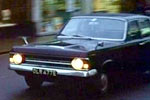 |
1967 Ford
Zephyr 4 Mark IV
Registration OLR 477E
Incidental Vehicle |
Also appeared
in:
Randall and Hopkirk (Deceased) - 'All
Work and No Pay', 'Money
to Burn', 'The Man from Nowhere', 'The Ghost Talks' |
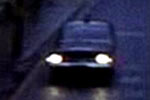 |
1967 Ford
Zephyr 4 Mark IV
Registration OLR 477E
This is the same
car as above, now doubling as a police car |
Also appeared
in:
Randall and Hopkirk (Deceased) - 'All
Work and No Pay', 'Money
to Burn', 'The Man from Nowhere', 'The Ghost Talks' |
|
Images © ITV
Studios, 1968 |
-
Seen It All
Before? The crew returned to the Elstree Studios
backlot, where they had been filming the park bench
sequence for the previous episode,
Whoever Heard of a Ghost Dying? The
jetty stretching out into the water tank can be seen
in the background in those shots, and is used here
more extensively for the scene where Jeff talks to
Marty and then the old lady.
-
The sequence
showing Marty dancing on stage, weaving between the
female dance troupe, is all too familiar as the
footage had been borrowed and superimposed into an
earlier episode,
It's Supposed To Be Thicker Than Water.
-
The song that
Gloria Marsh (Grazina Frame) performs on stage,
Out to Get You, composed by Chris
Andrews, had previously featured in an episode of
The Saint, Portrait of Brenda
(Spring 1968), where it had been sung by Anna
Carteret in a recording studio. Both programmes used
the same recording, and the actual vocalist is
unknown.
-
The fur traders
warehouse interior set seen in
Whoever Heard of a Ghost Dying?
was redressed for this episode, notably with the
addition of Snowy's office. This set was long
thought to have been filmed on location at the
Palace Theatre, a suggestion that was made feasible
by the one-time presence of a spiral staircase at
the theatre, but the layout of the theatre does not
support the theory. Additionally, the lighting has a
different quality to the scenes shot in the theatre.
-
The hallway set
was heavily redressed to double as the theatre
foyer, and the interior of the cafe near the theatre
had been seen in the series before in
For the Girl Who Has Everything, where
it was dressed as the interior of The Buttery.
-
The corridor with
the sloping floor and industrial lighting was a set
that had previously been used in The Champions
as the interior of an arctic base in Operation
Deep Freeze, a production also directed by Paul
Dickson.
-
Cock-ups...
This is an episode that features a cock-up before it
even begins - in the ITC synopsis provided to
television companies and the press. It goes to some
lengths to explain what went wrong with Fernandez
and Abel's "Russian Roulette" act, describing that
"one cartridge is live; the others blank. The
routine has been performed time and time again, but
this time the live cartridge is in the wrong
chamber." In the episode, there is only one bullet
in the gun, and it is meant to be a blank cartridge,
but it is a live round because it has been switched
by the member of the audience asked to load it.
-
Due to the tight filming schedule
at the Watford Palace Theatre location, the exact
same audience of extras are seen sitting in the same
seats for performances taking place on two
consecutive nights. Was there
nothing else to do in this town? Or maybe they
enjoyed witnessing Fernandez's murder so much that
they came back hoping for more!
-
Torch
singer
Gloria Marsh mentions to Jeff that her late husband's
mind-reading act, The Fabulous Fernandez and Abel,
was not the greatest success. Gloria's singing
career has been on the rise, and compared to her
husband's act, it is markedly more profitable.
Considering that as the episode progresses, we
discover that the mind-reading act was only a part
of the bill of the variety show at the Palace
Theatre, it is somewhat odd that the billboards
around the theatre show Fernandez and Abel and none
of their fellow acts. Since Gloria is clearly the
star of the show and her husband and his partner
are quite some way down the bill, surely the advertising should
have depicted her with Fernandez and Abel - "The
Greatest Mind Reading Act in the World" - as
co-stars of a lesser billing? Obviously, this is a
directorial choice, but it doesn't make sense within
the narrative.
|
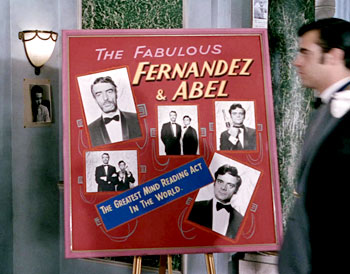
Image © ITV
Studios, 1968 |
-
At 7 minutes and 31 seconds into the episode,
Inspector Nelson (Michael Griffiths) admonishes
Jeff, saying "...you should have stayed at the
theatre as a witness, and you know it, but you
wanted your blood money!" What is unclear here is
why Jeff didn't remain at the theatre since he made
the call to the newspaper from a phone booth in the
theatre foyer. After ending the call, why
didn't he return to the scene of the crime?
-
At 12 minutes and
10 seconds into the episode, the stage manager
(James Belchamber) arrives to see Jeff's audition piece on stage. As he
goes to his seat, Marty realises that he is sitting
where the man wants to sit, so the ghost gets up and
moves to the next seat. Despite the fact that the
stage manager cannot see Marty, he waits for him to
vacate the seat before he himself sits down. This is
actually a mistake by the film labs where they have
miss-cut the negative. The point where the stage
manager stops when he gets to the seat is the usual
freeze point as shouted by the director. The actors
hold their position and you just see Kenneth Cope
then start to move and then it cuts to the next shot
with the stage manager and Marty already in their
seats. Unfortunately, the action of not cutting the
negative in the right place meant the tail end of
the shot facing the stage, with Marty popping across
to the adjacent seat and the stage manager sitting
down, was lost as the duration there was fixed. As
this was not what the director or film editor
planned for this sequence, when the episode was
restored for the 2017 Network Blu-ray release, the
restoration team debated whether to cut the end of
that first shot down. However, as this would have
resulted in even more of a jump in action to the
following scene it was decided to leave it as was.
-
When Jeannie is applying Jeff's
make-up in the dressing room at 15 minutes and 12
seconds into the episode, Jeff asks her about Abel:
"You saw his face when he looked down at that body.
Did he look like a man who had just killed his
partner?" This seems like an odd question to ask, as
there was no question that Abel had shot and killed
Fernandez. It would seem that either Ray Austin's
script or actor Mike Pratt omitted the word
"deliberately" or "intentionally", as that is what
Jeff is clearly meaning.
-
When Marty bows
to the audience, his tie is hanging out. When the
shot cuts to a close-up and he is back standing it
has magically become tucked inside his jacket.
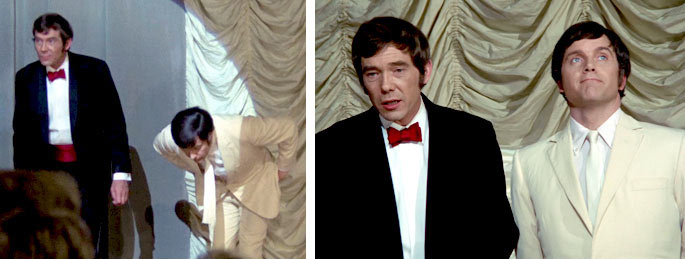 |
|
Images ©
ITV Studios, 1968 |
|
-
At 43 minutes and
11 seconds, one of Inspector
Nelson's colleagues enters the auditorium through
the double doors. He slams the door behind him, but
it makes no audible noise.
-
At 48 minutes and
41 seconds, Michael Griffiths
(playing Inspector Nelson) appears to find something
amusing and nearly breaks out of character. In fact,
the whole scene feels rather rough around the edges,
as though previous takes had been difficult and the
cast had broken into fits of the giggles.
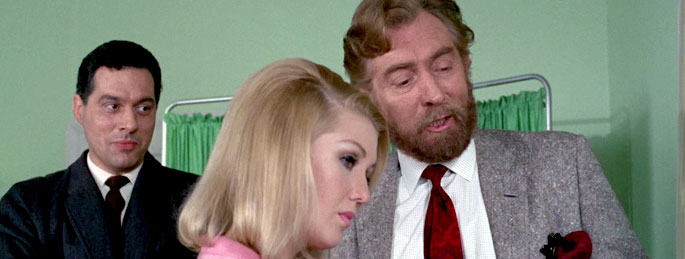 |
|
Image ©
ITV Studios, 1968 |
|
-
In the end credit
sequence, titlers Chambers and Partners once again
drop a clanger, this time by crediting actor John
Cazabon as "John Gazabon"!
-
And Finally... On Sunday 13th December 2015,
Randall and Hopkirk fans (including the team behind
this website) gathering for their Christmas
get-together were delighted to be introduced to
singer-actress Grazina Frame, who played chanteuse
Gloria Marsh in That's How Murder Snowballs.
Grazina was warmly welcomed and regaled us with
stories of her time working on Randall and
Hopkirk (Deceased) and other productions made at
Elstree. She also spoke of how she worked and became
friends with many of the greats of music and
television - comedians Eric Morecambe and Ernie
Wise, singer Tommy Steele and actor and entertainer
Reg Varney, among many others. Although she had not
kept any memorabilia from her Randall and Hopkirk
episode, she did bring along the dress which she
wore as Gloria Marsh - a dress which she had made
herself. A very talented and delightful woman, whom
it was a massive pleasure to meet.
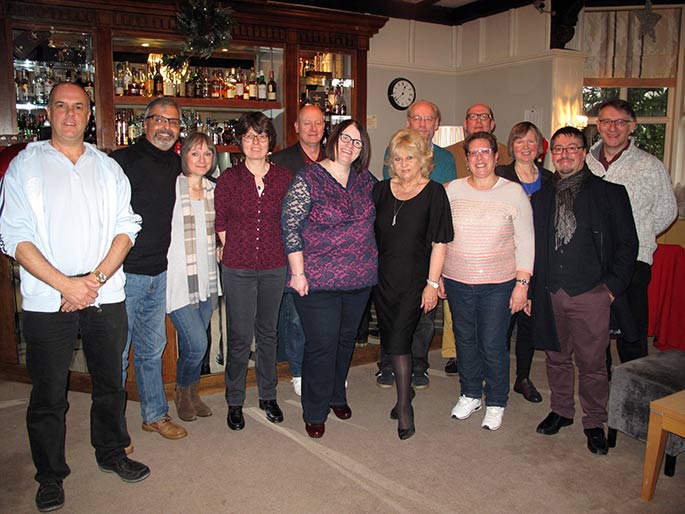 |
|
Grazina Frame
meets the RAHDAS gang! |
|
|
|
|
Plotline: Scoton Productions / ITC UK
Transmissions by Simon Coward and Alan Hayes
Review by Alan Hayes Declassified by
Alan Hayes
with thanks to Simon Coward, Vince Cox, Alys Hayes, John
Holburn and Andrew Pixley
All timings given on this page relate to the Blu-ray editions of this episode |
|
Back to
Programmes Index
Forward to All Work and No Pay
Locations:
That's How Murder Snowballs
|
|
|
Back to Top |
|



